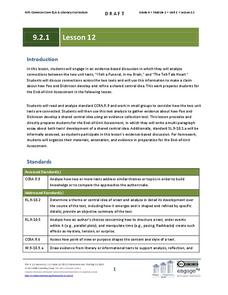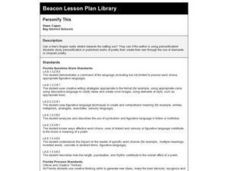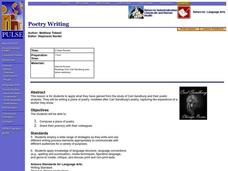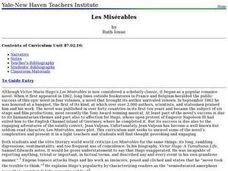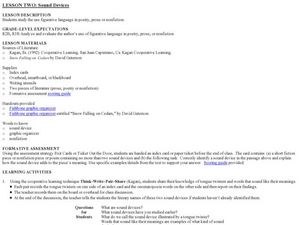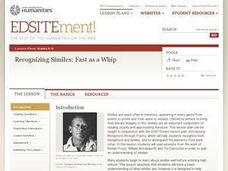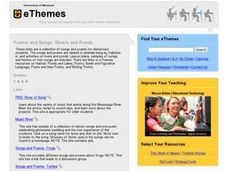Curated OER
Chasing Metaphors
Students use metaphors in order to see commonly experienced objects, events, and people in new and more meaningful ways.
EngageNY
Grade 9 ELA Module 2: Unit 1, Lesson 13
Whether the planks hide the beating of a hideous heart or they break away to the madness beneath, their presence makes itself known in the final instructional activity of a literary analysis unit. Having gathered textual evidence from...
EngageNY
Grade 9 ELA Module 2: Unit 1, Lesson 12
What happens when a tenuous grasp on sanity begins to slip? Compare Edgar Allan Poe's "The Tell-Tale Heart" and Emily Dickinson's "I Felt a Funeral, in my Brain" with a lesson plan focused on developing a common central idea. High...
Curated OER
A Mirror into History
Are we really all that different from people in the past? First, learners of all ages write an autobiographical poem. Then, they research the lives of historical figures. They use the same format that they used to write their own poem to...
Curated OER
Discovering Language Arts-Intermediate Fiction
Explore the elements of science fiction. Young scholars investigate the literary elements present in science fiction and write their own science fiction stories.
Curated OER
Rewriting Shakespeare
Have your learners play around with Shakespeare's language. In this plan, small groups examine and rearrange soliloquies from Othello, noting how the language changes and morphs. All groups have a chance to change each soliloquy, making...
Curated OER
Personify This
Eighth graders study personification in published works of poetry, then create their own through the use of diamante or cinquain poetry. They read and discuss poetry by Shel Silverstein, William Jay Smith, and Elinor Wylie.
Curated OER
Personalized Poetry Portfolio
Eighth graders create their own poetry portfolio containing poems that relate to Students' lives and families. The portfolio consist of the following types of poems: acrostic, diamante`, haiku, cinquain, and free verse.
Curated OER
Cluing into Symbols Robert Frost
Students use the Internet and video to discover how find evidence in poetry in order to discover the theme(s) of the poems. They are able to define poetic devices like simile, metaphor and repetition. Students identify themes in...
Curated OER
Poetry Writing
Students compose a piece of poetry modeled after the poetry of Carl Sandburg and share their poem(s) with their colleagues. They use a cluster diagram to organize their thoughts and brainstorm their ideas.
Curated OER
Lift Every Voice and Sing
Students analyze sculpture, poetry, and music to gain an understanding of historical events. In this critical thinking skills lesson, students take a closer look at African-American history as they examine "Lift Every Voice and Sing'"...
Curated OER
Snow Similies
Young scholars listen to poems to explain how poets use words to paint pictures. They use hands-on materials to practice using similies and figurative language to write a poem about snow.
Curated OER
- Making Metaphors with Munchies
Students brainstorm independently first, then ask their best friend on the team, or seat partners, depending on the year & student mix, to add to their list of personal characteristics and/or to name three words they think of...
Curated OER
ACROSTIC POETRY
Students use newspapers or magazines to create an acrostic poem where words are divided into parts of speech.
Curated OER
Review Poetry and the Simile and the Metaphor
Learners compile a list of the things they look for in a friend. Then they use that information to create a simple poem. Later they illustrate and display their poems.
Curated OER
Rhyming Word Poems
Students create poetry. In this poetry instructional activity, students read poetry and identify rhyming words using highlighters. Students may also add rhyming lines to the poetry they read.
Curated OER
Les Mis'rables
Students read, understand, and enjoy Les Miserables. They improve their skills in literary analysis, writing, and listening. Through the study of biblical and historical allusions, symbols, metaphors, and other figurative language, they...
Curated OER
Figurative Language
Students put poetic interpretations back together to explain the poem. Starting with cliches, students learn what various phrases mean. They analyze words, phrases and levels of meaning.
Alabama Learning Exchange
J. Alfred Hyperbolizes
Mermaids will sing to your class members as they engage in an activity related to T.S. Eliot's famous dramatic interior monologue. After engaging in a socratic seminar about literary devices in the poem, individuals choose one...
Curated OER
Poetry of Abraham Lincoln
Fourth graders analyze Abraham Lincoln's poems "The Bear Hunt" and "My Childhood's Home" for word choice and deeper inquiry into the vocabulary he uses to convey emotion. They identify rhyming words and patterns in these poems. ...
Curated OER
Sound Devices
Students examine the impact of sound devices in poetry, prose, and non-fiction. In this figurative language lesson, students read instructor-selected literature and identify uses of alliteration, repetition, consonance, rhythm, rhyme,...
Curated OER
Recognizing Similes: Fast as a Whip
Students review basic knowledge of similes and engage with similes on a more abstract level. In this similes activity, students define similes and identify examples. Students read and analyze the similes used in poetry by Derricotte,...
Curated OER
The American Dream Poetry
Students analyze how poetry can reveal themes of 'The American Dream.' In this poetry themes lesson plan, students discuss the elements of poetry and define imagery. Students read 'Lost Sister' by Cathy Song and complete a related...
Curated OER
Poems and Songs: Rivers and Ponds
Young scholars explore songs and poems related to the animals, habitats, and activities on rivers and ponds. They listen to song clips, explore various websites, read poems and song lyrics, complete worksheets, and define key vocabulary...




